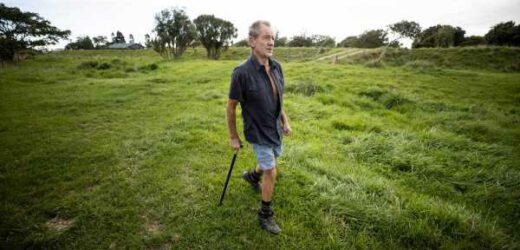Tony Ibbotson could see his house and he had a plan.
He almost had time to reflect on just how amazingly calm one can be in times of extreme danger.
After 40 years of flying, amassing more than 11,000 hours, he had been in sticky situations before and always walked away smiling. He didn’t think this would be any different.
But there were worrying signs.
Within seconds of dropping off his hunter mate at 4500 feet (1370m), high in the spectacular Kahurangi National Park on the South Island’s rugged West Coast, his Robinson R22 helicopter had suddenly begun shuddering. Violent, “very serious” vibrations rocking in at two to three-second intervals.
A bottle of water between his feet was hopping up and down.
The 71-year-old Ibbotson had never experienced anything like it. Quickly, he went into problem-solving mode.
There was nowhere to land in the thick National Park.
He couldn’t fly back up to where he left the hunter.
Options were limited.
“I took all the power off the machine so I could think,” Ibbotson recalls.
Think.
He could tell the vibrations weren’t coming from either the main rotor or tail rotor.
But he could feel it through his seat, in his back – and it was loud.
“It felt like it was coming right through the machine,” he says. “I thought it had to be coming from the tail rotor driveshaft as that’s the only other real moving part.”
Ibbotson decided to put the machine “virtually into autorotation” – a state of flight where the main rotor system is being turned by the force of the relative wind rather than engine power.
That’s all he felt he could do.
He hoped to fashion a sideways glide, down to the flat ground of Karamea – away from the mountainside, bush, and trees – at around 25 to 30 knots of ground speed.
Karamea is at the top of the South Island’s West Coast. At the end of a no-exit highway which backs onto the National Park; a secluded microclimate Ibbotson has called home for 41 years.
A butcher and chef by trade, Ibbotson was a commercial fisherman when he arrived in the pretty coastal town from Takaka in 1981.
But he soon got into commercial helicopter flights – working with the Department of Conservation (DoC), fishermen, rafters.
He had a national wild animal recovery operations (WARO) concession from DoC which gives concession for pig, goat and chamois carcass recovery and the live capture of deer, pig and goat.
On the morning of January 2 this year, he had done a short photographic flight over Karamea’s main street.
Then, around 4pm, he took a deer hunter into Kahurangi – above an area called Discovery Creek.
There had been no issues in pre-flight checks, taking off, or during the short flight to where he dropped the hunter off.
But within seconds of lifting off to fly back home, a sudden vibration hit the machine – one he had spent around 1500 hours flying in and knew well.
Any time he tried to apply any power, it shuddered awfully.
“There was nothing else I could do until I got to grassland in Karamea – I just had to bite the bullet,” he says.
It was normally a pleasant 12 to 15-minute flight back home.
But Ibbotson had other things on his mind than the scenery. The vibrations were still juddering through him unabated.
He thought he had two choices: A running landing at the town’s airport, which would have required power, or a landing in a grass paddock just 100m from his house.
It had been raining, and Ibbotson knew the grass would be soft. He thought if he came in at an altitude of around 15 to 20ft, still flying sideways, and could straighten the machine up at the last minute to avoid rolling, he could then try and dump a landing.
“That was my choice,” he says.
“I’ve been in tricky situations before, obviously. It’s part and parcel of it.
“It felt like it could fly to bits at any moment and I was just doing my best to get it down.
“I was planning to walk away from it.”
Coming over the Karamea River, and aiming for a gap between two trees, he eyed his landing spot in the paddock.
As soon as he tried to correct the machine, however, when he was about 15ft above the ground, it broke suddenly, catastrophically.
“It flew to pieces,” Ibbotson says.
“It happened in a split second. All I can remember was something centrifugal happening – bang – and from what other people have told me, the machine did a 360-degree turn, a nose up, and a nose down.”
Holidaymakers from the nearby camping ground, and from the Last Resort hotel that Ibbotson built in the 1990s, came running.
His daughter Joelle Fox, a paramedic who lives in Westport, happened to be visiting that day.
She rushed to find her father conscious but disorientated and lying badly injured in the wreckage.
Both the local ambulance and fire station is based just 150m from the crash site. They arrived swiftly.
Ibbotson remembers being dragged from the crumpled chopper in severe pain and waiting for the Nelson rescue helicopter to airlift him to hospital.
His right hip was smashed in the crash-landing.
Several operations – firstly at Nelson, and then at Christchurch Hospital – have been needed to help him walk again. Multiple screws have been put in.
Physiotherapy is ongoing for nerve damage but he’s back walking with aid of a stick.
And he hopes the TAIC investigation will clear him of any wrongdoing and he can get his pilot’s licence back.
He still thinks he did all he could that day.
“If I had tried to land it on the [concrete] helipad here, sheesh… they would still be picking up bits and pieces.”
Pieces of debris were found more than 100m away in the Karamea River.
Ibbotson knows is “extremely lucky” to be alive.
“I believe, had I pulled power between there and here, they would still be looking for bits of me in the National Park,” he says.
Ibbotson’s theory is a fault has occurred somewhere along the tail rotor driveshaft, between the machine’s two gearboxes.
Transport Accident Investigation Commission (TAIC) officers, who launched an investigation hours after the crash, later interviewed Ibbotson for two hours.
“I’m not blaming anybody,” Ibbotson says.
“It’s up to the authorities looking at the machine to determine what happened, but it’s not a matter of blaming anyone, it’s about making sure it doesn’t happen again.
“Obviously something went wrong with the machine. I didn’t crash it, the machine crashed me.”
He’s not been put off flying – even though he’s grounded now while his licence is suspended – an automatic move after any crash investigation is launched.
And it’s not put him off Robinsons, which have a controversial safety record in New Zealand.
Ibbotson, who has owned several of the machines over the years, has even bought a new one, a Robinson 22 – same model, same colour.
“I have no problem with the machine itself. The reputation [Robinsons] have is because of mast-bumping, which is pilot error. That’s not what happened here,” Ibbotson says.
“I do miss flying. I know the National Park like you know your own backyard. I know the trees, the rocks, everything.
“I’m in the situation now where I don’t have to fly for the money. It’s because I want to do it, it’s in the blood.”
The TAIC inquiry is ongoing.
Source: Read Full Article

/cloudfront-ap-southeast-2.images.arcpublishing.com/nzme/G26VWGXHYRVZEDBOTSOYT4BCWU.jpg)
/cloudfront-ap-southeast-2.images.arcpublishing.com/nzme/UTJIG6HR45KFQKIDQREL5OGBVI.jpg)
/cloudfront-ap-southeast-2.images.arcpublishing.com/nzme/6AFZGK4PNHJAGJDAHUP5ID2WV4.jpg)
/cloudfront-ap-southeast-2.images.arcpublishing.com/nzme/GURGIFILRZA6KBAAJUCNMWF5Y4.jpg)

